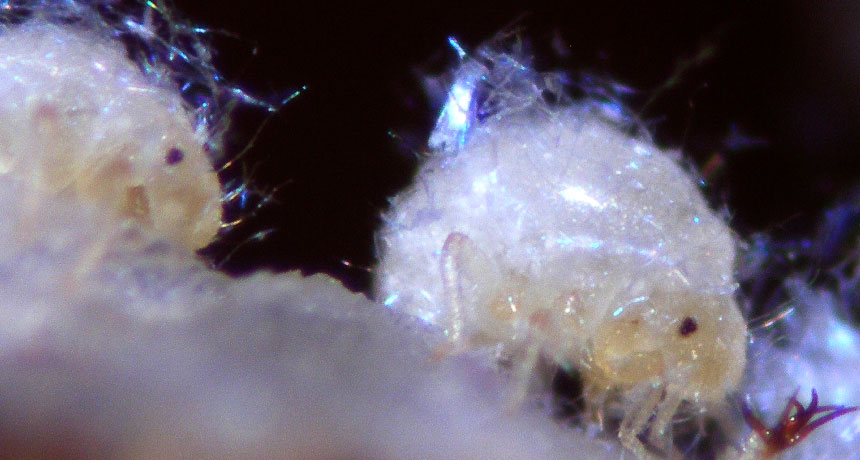
INTO THE BREACH Plumped-up young aphid soldiers rush to sacrifice themselves to repair a hole in the wall protecting their colony in an Asian winter hazel tree.
Mayako Kutsukake
However badly that home renovation goes, be glad you’re not a young aphid.
Colonies of tiny Nipponaphis monzeni aphids in eastern Asia use their own young as part repair crew, part repair goo. The tiny fluffs of juvenile insects end up dying after gushing white glop from their bodies to repair a hole in the wall protecting their colony in Asian winter hazel trees. New details of this patching chemistry suggest that these doomed young aphids are a colony’s version of immune system cells, researchers report April 15 in the Proceedings of the National Academy of Sciences.
Sign up for our newsletter
We summarize the week's scientific breakthroughs every Thursday.
The need for repair can arise while hundreds or thousands of these aphids live inside a hard-shelled, closed lump called a gall, which forms on the trees and balloons around the insects over several years. When a caterpillar manages to chew through the wall, white wingless aphid youngsters called soldiers, swollen almost to bursting with fluids, rush to the breach.
Some soldiers mob and sting the intruder. Others get on with patching the hole. They “erupt,” says evolutionary biologist and entomologist Takema Fukatsu of the National Institute of Advanced Industrial Science and Technology in Tsukuba, Japan. From paired openings, or cornicles, near the rear, each soldier pops out huge (in aphid terms) white gobs of fatty substances and other compounds that plaster the hole.

Some aphids get fatally stuck in the hardening patch, and some perish marooned outside the gall. As for the rest, releasing so much fluid shrivels the half-millimeter-long youngsters down to about a third of their body size. That means “the soldiers must die sooner or later,” Fukatsu says.
These fatty substances normally stay inside the aphids’ bodies in large cells along with the enzyme phenoloxidase. That combo does basically nothing when confined. Eruption, however, frees the fats and enzyme to react with compounds from the insects’ equivalent of blood.
The doomed youngsters work the goo as if treading grapes. The fatty substances clot, and melanin created as compounds mix will cause the patch to darken and harden. Like immune system cells flooding a skinned knee, the aphid soldiers form a scab.
They do it fast, too. A soldier releases about 0.01 to 0.03 microliters of goo in a one-time-only discharge. Yet drop by drop, the emergency crew can scab over a pinhead-sized hole in about 30 minutes.
This creature isn’t the only aphid species that relies on the self-sacrifice of some for the survival of many. Young cabbage aphids (Brevicoryne brassicae) aren’t closely related to the scab makers, says evolutionary biologist Carol von Dohlen of Utah State University in Logan. But in their independently evolved form of heroism, these aphids build up a defensive chemical, a mustardy toxin. Crushing one of these soldiers releases a nasty mouthful as well as a compound that serves as an alarm signal that can benefit other aphids. Tiny they may be, but “aphids are surprising,” she says.






